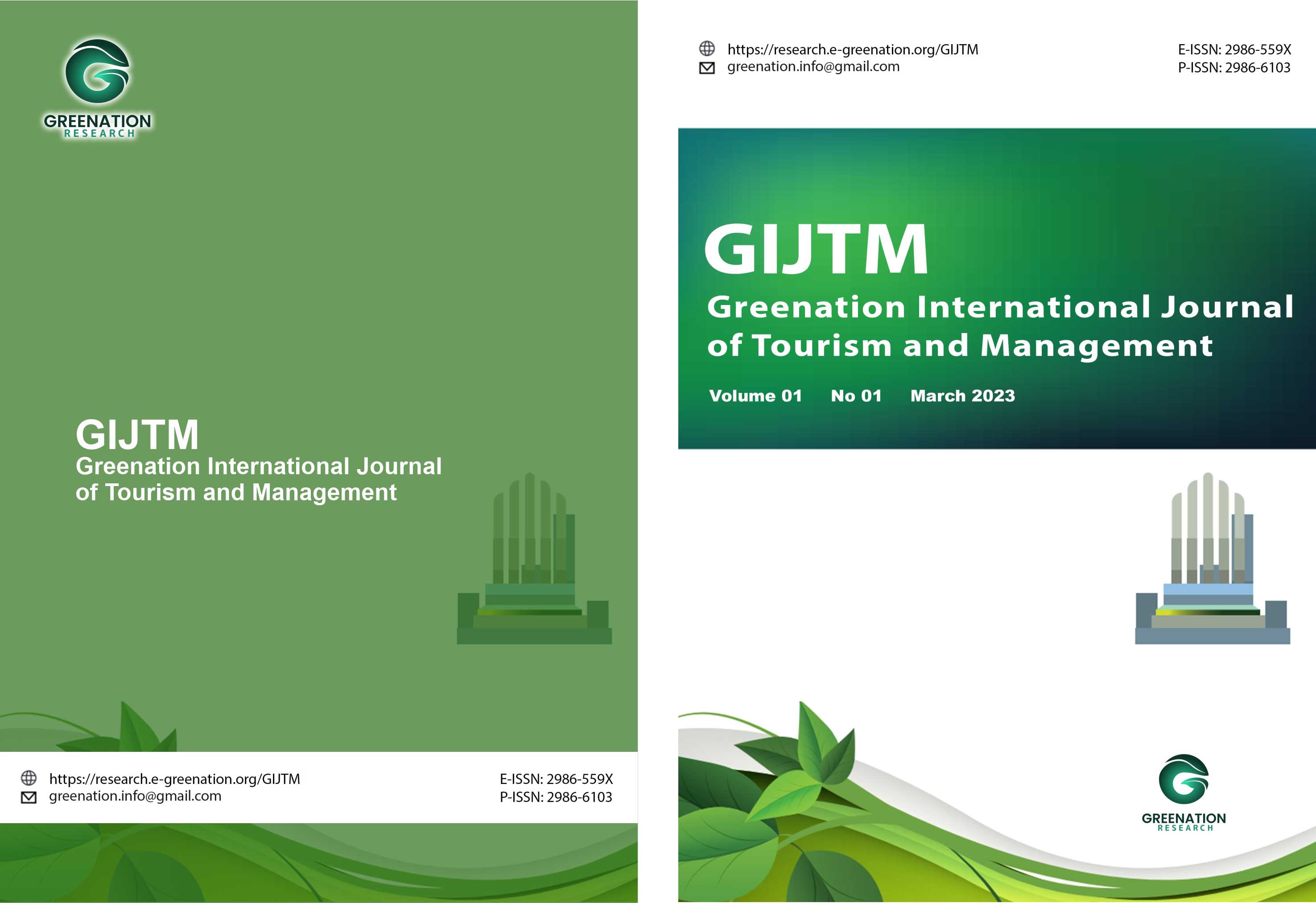Analysis of Competency, Discipline, and Self-Efficacy on The Performance of Aviation Security Staff: Literature Review
DOI:
https://doi.org/10.38035/gijtm.v2i3.239Keywords:
Competency, Discipline, Self-Efficacy, Performance, Aviation Security, StaffAbstract
This research aims to see the influence between variables and analyze the factors that cause personal aviation security performance. This research uses a literature review study to systematically review previous articles to see their correlation with current research. The results show that there is an influence between all independent variables on the dependent variable. This finding could be something new in qualitative research, aviation security performance can improve with competency appropriate to their field of work, work discipline while on duty, and self-efficacy at all levels, thereby creating good work achievements according to management's expectations. In human resource management research, there is no research framework like this article and the hypotheses in this research are very rarely found in previous research. Purpose – This research builds a theory of whether there is an influence between independent variables on the dependent variable. Design/methodology/approach – The method used is library research which analyzes previous articles as a literature review. Findings – There is a significant influence between variable X1 on Y, variable X2 on Y, and variable X3 on Y. Research limitations/implications – Many other factors influence performance, including remuneration, motivation, leadership style, and job satisfaction. Practical implications – The depth of this research reviews the performance of personal aviation security who are tasked with checking the luggage of passengers entering the airport area. Originality/value – Researchers have tried to look for the same research model but have not found it, there has never been previous research that discusses the influence of the independent variable on the dependent variable.
References
Abdelwahed, N. A. A., Soomro, B. A., & Shah, N. (2022). Predicting employee performance through transactional leadership and entrepreneur’s passion among the employees of Pakistan. Asia Pacific Management Review, xxxx. https://doi.org/10.1016/j.apmrv.2022.03.001
Afrasiabi, A., Chalmardi, M. K., & Balezentis, T. (2022). A novel hybrid evaluation framework for public organizations based on employees’ performance factors. Evaluation and Program Planning, 91(September 2021), 102020. https://doi.org/10.1016/j.evalprogplan.2021.102020
Aka, S., & Akyuz, G. (2015). The Effect of Production Management Course on the Self-Efficacy of Employees. Procedia - Social and Behavioral Sciences, 197(February), 108–112. https://doi.org/10.1016/j.sbspro.2015.07.064
Aktas, E., & Kagnicioglu, C. H. (2023). Factors affecting safety behaviors of aircraft maintenance technicians: A study on Civil Aviation Industry in Turkey. Safety Science, 164(April), 106146. https://doi.org/10.1016/j.ssci.2023.106146
Alanazi, M. S. M., Jenkins, K., & Li, J. (2024). Predicting passengers’ feedback rate for airport service quality. Transportation Research Interdisciplinary Perspectives, 24(April 2023), 101046. https://doi.org/10.1016/j.trip.2024.101046
Ali, H., & Limakrisna, N. (2013). Metodologi Penelitian (Petunjuk Praktis Untuk Pemecahan Masalah Bisnis, Penyusunan Skripsi (Doctoral dissertation, Tesis, dan Disertasi. In In Deeppublish: Yogyakarta.
Andang P, K., & Hardiyana, A. (2021). Effect of Work Supervision and Discipline on Employee Performance. Jurnal Ekonomi, Bisnis & Entrepreneurship, 15(2), 92–100. https://doi.org/10.55208/jebe.v15i2.241
Arcúrio, M. S. F., Nakamura, E. S., & Armborst, T. (2018). Human Factors and Errors in Security Aviation: An Ergonomic Perspective. Journal of Advanced Transportation, 2018. https://doi.org/10.1155/2018/5173253
Arisman. (2022). The Effect of Leadership Style and Motivation on Employee Performance. Jurnal Multidisiplin Madani, 2(5), 2389–2404. https://doi.org/10.55927/mudima.v2i5.388
Cherian, J., & Jacob, J. (2013). Impact of Self Efficacy on Motivation and Performance of Employees. International Journal of Business and Management, 8(14), 80–88. https://doi.org/10.5539/ijbm.v8n14p80
Dando, C. J., & Ormerod, T. C. (2020). Aviation security by consent using the Controlled Cognitive Engagement (CCE) alternative screening programme. Journal of Air Transport Management, 86(April), 101824. https://doi.org/10.1016/j.jairtraman.2020.101824
Eliyana, A., Ma’arif, S., & Muzakki. (2019). Factors That Influence Employee Performance: Motivation, Leadership, Environment, Culture Organization, Work Achievement, Competence and Compensation (A Study Of Human Resource Management Literature Studies). European Research on Management and Business Economics, 25(3), 144–150. https://doi.org/10.1016/j.iedeen.2019.05.001
Gajewicz, ?., Walaszczyk, E., Nadolny, M., & Nowosielski, K. (2022). Criteria of quality assessment of regional airport services - A very last picture before the COVID-19 pandemic. Journal of Air Transport Management, 103(July 2021). https://doi.org/10.1016/j.jairtraman.2022.102231
Gillen, D., & Morrison, W. G. (2015). Aviation security: Costing, pricing, finance and performance. Journal of Air Transport Management, 48, 1–12. https://doi.org/10.1016/j.jairtraman.2014.12.005
Halteh, K., AlKhoury, R., Adel Ziadat, S., Gepp, A., & Kumar, K. (2024). Using machine learning techniques to assess the financial impact of the COVID-19 pandemic on the global aviation industry. Transportation Research Interdisciplinary Perspectives, 24(April 2023), 101043. https://doi.org/10.1016/j.trip.2024.101043
Hameed, Abdul, A. W. (2011). Employee Development and Its Affect on Employee Performance A Conceptual Framework. International Journal of Business and Social Sciences, 2(13), 224–229.
Hasanah, F., & Singmin Johanes Lo. (2020). The Mediating Role of Employee Satisfaction on the Influences of Employee Discipline and Employee Motivation on Employee Performance At the Ministry of Transportation, Republic of Indonesia, Research and Development Department. Dinasti International Journal of Management Science, 2(1), 1–11. https://doi.org/10.31933/dijms.v2i1.512
Huo, M., & Jiang, Z. (2023). Work – life conflict and job performance?: The mediating role of employee wellbeing and the moderating role of trait extraversion. Personality and Individual Differences Journal, 205(February). https://doi.org/https://doi.org/10.1016/j.paid.2023.112109
Kankaew, K. (2020). The competence that satisfy us: Agribusiness and airlines business management cases. E3S Web of Conferences, 175. https://doi.org/10.1051/e3sconf/202017513032
Kazda, A. (2017). Airport Planning and Design – Legal and Professional Competence Requirements. Civil and Environmental Engineering, 13(2), 143–148. https://doi.org/10.1515/cee-2017-0019
Liang, C. J., Lin, Y. L., & Huang, H. F. (2013). Effect of core competence on organizational performance in an airport shopping center. Journal of Air Transport Management, 31(1), 23–26. https://doi.org/10.1016/j.jairtraman.2012.11.005
Liu, X., Zheng, X., Lee, B. Y., Yu, Y., & Zhang, M. (2023). COVID-19 and employee job performance trajectories: The moderating effect of different sources of status. Journal of Vocational Behavior, 142(February). https://doi.org/10.1016/j.jvb.2023.103862
Maden-Eyiusta, C., & Alten, O. (2023). Expansion-oriented job crafting and employee performance: A self-empowerment perspective. European Management Journal, 41(1), 79–89. https://doi.org/10.1016/j.emj.2021.10.012
Maryani, Y., Entang, M., & Tukiran, M. (2021). The Relationship between Work Motivation, Work Discipline and Employee Performance at the Regional Secretariat of Bogor City. IJOSMAS?: International Journal of Social and Management Studies, 2(2), 1–16.
Minh, N. Van, Badir, Y. F., Quang, N. N., & Afsar, B. (2017). The impact of leaders’ technical competence on employees’ innovation and learning. Journal of Engineering and Technology Management - JET-M, 44, 44–57. https://doi.org/10.1016/j.jengtecman.2017.03.003
Mukhalipi, A. (2018). Employee Discipline Enhances Employee Engagement: An Affective Shift Model Perspective - A Literature Review. Texila International Journal of Management, 4(1), 59–69. https://doi.org/10.21522/tijmg.2015.04.01.art006
Poole, R. W. (2015). Fresh Thinking on Aviation Security. Journal of Air Transport Management, 48, 65–67. https://doi.org/10.1016/j.jairtraman.2015.06.014
Price, J., & Forrest, J. (2016). Practical Aviation Security: Predicting and Preventing Future Threats. Elsevier Science. https://books.google.co.id/books?id=yIt4CgAAQBAJ
Rahimi?, Z., Resi?, E., & Kožo, A. (2012). Determining the Level of Management Competences in the Process of Employee Motivation. Procedia - Social and Behavioral Sciences, 41, 535–543. https://doi.org/10.1016/j.sbspro.2012.04.066
Risby, J., Guest, S., & Warnock-Smith, D. (2022). A critical analysis of Bristol Airport’s employee surface access habits: Developing strategic recommendations for reducing private vehicle usage. Research in Transportation Business and Management, 43(July 2021), 100700. https://doi.org/10.1016/j.rtbm.2021.100700
Simarasl, N., Tabesh, P., Munyon, T. P., & Marzban, Z. (2022). Unveiled confidence: Exploring how institutional support enhances the entrepreneurial self-efficacy and performance of female entrepreneurs in constrained contexts. European Management Journal, June. https://doi.org/10.1016/j.emj.2022.07.003
Singh, S., & Singh, M. (2003). Explosives detection systems (EDS) for aviation security. Signal Processing, 83(1), 31–55. https://doi.org/10.1016/S0165-1684(02)00391-2
Sitopu, Y. B., Sitinjak, K. A., & Marpaung, F. K. (2021). The Influence of Motivation, Work Discipline, and Compensation on Employee Performance. Golden Ratio of Human Resource Management, 1(2), 72–83. https://doi.org/10.52970/grhrm.v1i2.79
Tamasi, G., & Demichela, M. (2011). Risk assessment techniques for civil aviation security. Reliability Engineering and System Safety, 96(8), 892–899. https://doi.org/10.1016/j.ress.2011.03.009
Tosun, C., Parvez, M. O., Bilim, Y., & Yu, L. (2022). Effects of green transformational leadership on green performance of employees via the mediating role of corporate social responsibility: Reflection from North Cyprus. International Journal of Hospitality Management, 103(April), 103218. https://doi.org/10.1016/j.ijhm.2022.103218
Trapote-Barreira, C., Deutschmann, A., & Robusté, F. (2016). Managing Airlines: The Cost of Complexity. Transportation Research Procedia, 18(June), 297–304. https://doi.org/10.1016/j.trpro.2016.12.039
Tuchen, S., Nazemi, M., Ghelfi-Waechter, S. M., Kim, E., Hofer, F., Chen, C. F., Arora, M., Santema, S., & Blessing, L. (2023). Experiences from the international frontlines: An exploration of the perceptions of airport employees during the COVID-19 pandemic. Journal of Air Transport Management, 109(December 2021), 102404. https://doi.org/10.1016/j.jairtraman.2023.102404
Van Overmeire, R., Vesentini, L., Van Keer, R. L., Muysewinkel, E., & Bilsen, J. (2021). Working experiences of airport employees after a terrorist attack in Belgium: A qualitative study. International Journal of Disaster Risk Reduction, 64(August), 102515. https://doi.org/10.1016/j.ijdrr.2021.102515
Walumbwa, F. O., Mayer, D. M., Wang, P., Wang, H., Workman, K., & Christensen, A. L. (2011). Linking ethical leadership to employee performance: The roles of leader-member exchange, self-efficacy, and organizational identification. Organizational Behavior and Human Decision Processes, 115(2), 204–213. https://doi.org/10.1016/j.obhdp.2010.11.002
Wandelt, S., & Wang, K. (2024). Journal of the Air Transport Research Society Towards solving the airport ground workforce dilemma?: A literature review on hiring , scheduling , retention , and digitalization in the airport industry. Journal of the Air Transport Research Society, 2, 100004. https://doi.org/10.1016/j.jatrs.2024.100004
Wang, C., Zhang, T., Tian, R., Wang, R., Alam, F., Hossain, M. B., & Illés, C. B. (2024). Corporate social Responsibility’s impact on passenger loyalty and satisfaction in the Chinese airport industry: The moderating role of green HRM. Heliyon, 10(1), 1–14. https://doi.org/10.1016/j.heliyon.2023.e23360
Wang, X., Wen, X., Liu, Z., Jiang, Y., & Huai, M. (2023). Leader Apology in the Employee–Organization Relationship: The Roles of Subordinate Power Distance Belief and Leader Competence. Tourism Management, 96(November 2022), 104694. https://doi.org/10.1016/j.tourman.2022.104694
Wiguna, M. (2020). The Effect of Discipline and Training Toward Employee Performance. Almana?: Jurnal Manajemen Dan Bisnis, 4(2), 197–204. https://doi.org/10.36555/almana.v4i2.1353
Yagil, D., Medler-Liraz, H., & Bichachi, R. (2023). Mindfulness and self-efficacy enhance employee performance by reducing stress. Personality and Individual Differences, 207(December 2022), 112150. https://doi.org/10.1016/j.paid.2023.112150
Yang, H., Weng, Q. X., Li, J. Y., & Wu, S. (2022). Exploring the relationship between trait emotional intelligence and adaptive performance: the role of situational strength and self-efficacy. Personality and Individual Differences, 196(July 2021), 111711. https://doi.org/10.1016/j.paid.2022.111711
Zhou, J., Bi, G., Liu, H., Fang, Y., & Hua, Z. (2018). Understanding employee competence, operational IS alignment, and organizational agility – An ambidexterity perspective. Information and Management, 55(6), 695–708. https://doi.org/10.1016/j.im.2018.02.002
Zu, L., Lu, Y., & Dong, M. (2024). A probabilistic model based on the peak-over-threshold approach for risk assessment of airport controllers’ performance. Journal of Safety Science and Resilience, 5(1), 110–118. https://doi.org/10.1016/j.jnlssr.2024.02.001
Downloads
Published
How to Cite
Issue
Section
License
Copyright (c) 2024 Primadi Candra Susanto, Ni Nyoman Sawitri, Hapzi Ali, Zahara Tussoleha Ronny

This work is licensed under a Creative Commons Attribution 4.0 International License.
Copyright :
Authors who publish their manuscripts in this journal agree to the following conditions:
- Copyright in each article belongs to the author.
- The author acknowledges that the Greenation International Journal of Tourism and Management (GIJTM) has the right to be the first to publish under a Creative Commons Attribution 4.0 International license (Attribution 4.0 International CC BY 4.0).
- Authors can submit articles separately, arrange the non-exclusive distribution of manuscripts that have been published in this journal to other versions (for example, sent to the author's institutional repository, publication in a book, etc.), by acknowledging that the manuscript has been published for the first time at GIJTM.


























